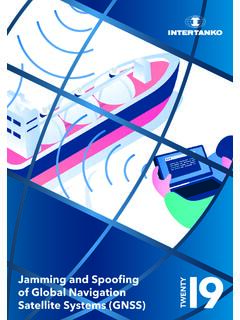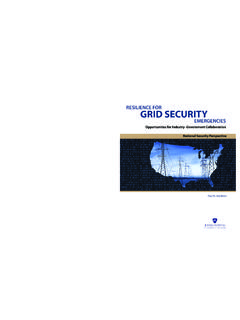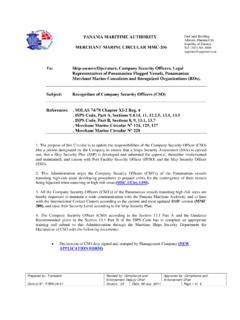Transcription of Guidelines for Owners, Operators and Masters for ...
1 _____ Guidelines for Owners, Operators and Masters for protection against piracy in the Gulf of Guinea region V3 June 2018 Guidelines for Owners, Operators and Masters for protection against piracy and armed robbery in the Gulf of Guinea region (Version 3, June 2018) To be read in conjunction with the Global Counter-Piracy Guidance for Companies, Masters and Seafarers (GCPG). Issued by ICS, BIMCO, Intercargo, IG P&I, INTERTANKO, Intermanager, OCIMF 1. Introduction Piracy and armed robbery in the Gulf of Guinea region is an established criminal activity and is of serious concern to the maritime sector. 2. Area for consideration Attackers in the Gulf of Guinea region are flexible in their operations so it is difficult to predict a precise area where a ship might fall victim to an attack.
2 For the purpose of this guidance the area off the coasts of Ghana, Nigeria, Togo, Cameroon, and Benin can be regarded as an area in which this guidance should be applied. Attacks have occurred from as far south as Angola and as north as Sierra Leone. In addition, the LMA Joint War Committee defines the following "Listed Areas for Hull War, Piracy, Terrorism and Related Perils": The territorial waters of Benin, Togo and Nigeria, plus Nigerian Exclusive Economic Zone north of latitude 3 N, plus Beninese Exclusive Economic Zones north of latitude 3 N plus. Togolese Exclusive Economic Zone north of latitude 3 N. The LMA Joint War Committee listed areas should be checked regularly for changes 3. Threat and Risk Assessment For the purpose of identifying suitable measures of prevention, mitigation and recovery in case of piracy, ship and voyage specific threat and risk assessment as recommended in Section 4 of GCPG should be carried out prior to entering the area described in Section 2 above.
3 Not unlike the Ship Security Assessment described in the ISPS Code, the risk assessment should include, but may not be limited to, the following: The threat (who are the attackers, what do they want to achieve, how do they attack, how do they board, which weapons do they use ) Background factors shaping the situation (visibility, sea-state, traffic patterns other commercial ships, fishermen and human traffickers etc.) _____ Guidelines for Owners, Operators and Masters for protection against piracy in the Gulf of Guinea region V3 June 2018 Possibilities for co-operation with military (escorting, employment of Vessel Protection Detachments, registering with authorities etc.) The ship s characteristics/vulnerabilities/inherent capabilities to withstand the threat (freeboard, speed, general arrangement etc.)
4 Ship s procedures (drills, watch rosters, chain of command, decision making processes etc.) In addition to the information found in this document, supplementary information about the characteristics of the threat and regional background factors may be sought from regional reporting centres, Shipping Association websites, the International Maritime Bureau (IMB), commercial intelligence providers or local sources such as ships' agents. As described in the GCPG, the risk assessment should take into consideration any statutory requirements, in particular those of the flag state and/or the coastal state. Other requirements dictated by company and insurance policies should also be taken into consideration. Much of this risk assessment already exists in the GCPG since it provides an overall list of which actions to take to defend against attack.
5 However, the guidance in the GCPG must be developed into specific actions and mitigation measures to apply on a ship-by-ship and voyage-by-voyage basis. For example, many attacks in the Gulf of Guinea region occur whilst ships are at anchor or drifting, in which case the GCPG self-defence measures like "evasive maneuvering" are not readily applicable. Thus, the risk assessment must reflect the prevailing characteristics of the specific voyage and ship, and not just be a repetition of advice relating to a different geographical region and a different attacking modus operandi. Detailed guidance on preparing risk assessments can be found from a variety of sources including the ISPS code. 4. Typical Attacks Attacks within the Gulf of Guinea are varied, and include armed robbery of crew and ship s property, cargo theft and kidnap for ransom.
6 Generally speaking, attacks in the Gulf of Guinea can be very violent and can be split broadly into the following categories: Armed Robbery In general this is opportunistic, is often violent, and occurs where ships are approaching, drifting, anchored off and berthed alongside at ports. For the most part the intention is to take valuables from the safe, IT equipment, and personal effects. Cargo theft This occurs throughout the area described with ships hijacked in anchorages and whilst underway further offshore. In the main it is related to product and chemical tankers but there are also attacks on general cargo carriers. Ships are hijacked for several days and cargo is transferred to a smaller ship. These incidents are well-organised, often involving a criminal element with commercial interests ashore.
7 Cargo thefts have demonstrated that attackers often have maritime knowledge allowing them to disable communications, operate the cargo system, etc. Kidnapping All seafarers and all types of ships are at risk. Instances of ships being attacked and seafarers taken ashore for ransom remain relatively common. The methodology is to take 4 to 5 _____ Guidelines for Owners, Operators and Masters for protection against piracy in the Gulf of Guinea region V3 June 2018 seafarers often the Master and Chief Engineer -as they command higher ransoms. However, there have been cases where 10 or more crew have been seized. Attacks in the Gulf of Guinea region usually involve approaches made by high-powered speedboats. The use of motherships is not widespread, although there is evidence that small cargo ships and fishing ships that have already been hijacked have been used to launch attacks against larger merchant ships.
8 The risk of an attack is higher when the ship is at anchor or is approaching or drifting off a port close to pilot station. Another vulnerable situation arises when STS operations and the two ships are adrift and moored alongside each other. For the tanker sector, cargo theft results in stolen oil products being sold in the region. For the dry cargo and other sectors, violent robbery is more common. Attacks, both outside and inside territorial waters, appear to be the result of well executed planning, with particular products such as gasoil or gasoline being targeted in well-coordinated operations. Companies and ships operating regularly in the region are likely to be at increased risk of falling subject to intelligence collection operations and subsequent attack.
9 5. Ship Movement Reporting Procedures Although this may change in the future, at present the Yaound reporting framework is not fully operational, with voluntary ship movement and reporting procedures handled by the MDAT-GoG. Masters have a number of options for reporting incidents and particularly: Maritime Domain Awareness for Trade Gulf of Guinea (MDAT-GoG): MDAT-GoG is a service operated by the French and UK navies from centres in Brest, France, and Portsmouth, UK and aims to develop, maintain and share details of the maritime domain picture of the waters off Africa s western seaboard. The MDAT-GoG administers a Voluntary Reporting Area (VRA) scheme under which merchant ships are encouraged to report position information while operating in the VRA.
10 The VRA, as shown on Admiralty Chart Q6114, has been issued to clearly define an internationally recognised area, so ship Operators and ships transiting, trading or operating in West Africa can join a trusted reporting scheme. The provision of Admiralty Chart Q6114 to all ships operating in the VRA is strongly recommended. Suspicious activity and incidents reported to MDAT-GoG by shipping in the VRA, using the forms on the Chart and repeated at Annex B, assist in the creation of a detailed and accurate regional maritime domain picture. The analysis is used to produce security recommendations that are shared with seafarers, ship Operators and law enforcement agencies to enhance risk awareness and improve incident response. The MDAT-GoG provides a 24-hour manned service of military experts.






